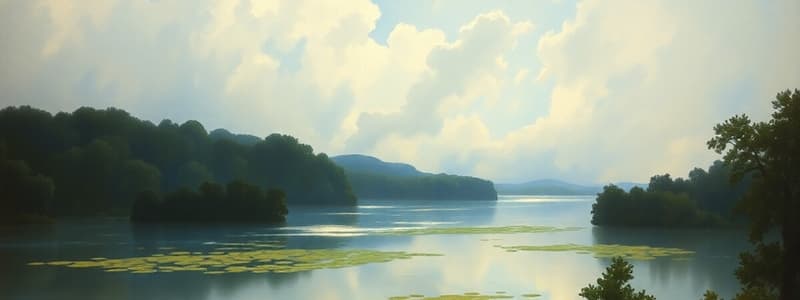Podcast
Questions and Answers
Which of the following is the most accurate representation of the percentage of carbon dioxide in the atmosphere?
Which of the following is the most accurate representation of the percentage of carbon dioxide in the atmosphere?
- 0.004%
- 4%
- 0.4%
- 0.04% (correct)
Which of the following processes releases carbon dioxide into the atmosphere?
Which of the following processes releases carbon dioxide into the atmosphere?
- Sedimentation
- Photosynthesis
- Combustion (correct)
- Dissolving
Which of the following is an example of locked up carbon found in rocks and minerals?
Which of the following is an example of locked up carbon found in rocks and minerals?
- Chalk (correct)
- Methane
- DNA
- Glucose
In what form is carbon stored in the ocean?
In what form is carbon stored in the ocean?
Which of the following is an example of an organic molecule that contains carbon?
Which of the following is an example of an organic molecule that contains carbon?
Which of these contributes to the long-term storage of carbon?
Which of these contributes to the long-term storage of carbon?
What impact does dissolving carbon dioxide in the ocean have on marine ecosystems?
What impact does dissolving carbon dioxide in the ocean have on marine ecosystems?
Which process primarily removes carbon dioxide from the atmosphere?
Which process primarily removes carbon dioxide from the atmosphere?
Which of the following best describes the role of carbon dioxide in the Earth's atmosphere?
Which of the following best describes the role of carbon dioxide in the Earth's atmosphere?
How do plants contribute to the relative stability of carbon dioxide levels in the atmosphere?
How do plants contribute to the relative stability of carbon dioxide levels in the atmosphere?
What is the approximate percentage increase in atmospheric carbon dioxide levels since the Industrial Revolution?
What is the approximate percentage increase in atmospheric carbon dioxide levels since the Industrial Revolution?
Before 1914, atmospheric carbon dioxide concentrations remained within a specific range. What was the approximate upper limit of this range in parts per million (ppm)?
Before 1914, atmospheric carbon dioxide concentrations remained within a specific range. What was the approximate upper limit of this range in parts per million (ppm)?
Which process releases carbon dioxide back into the atmosphere?
Which process releases carbon dioxide back into the atmosphere?
What is the primary source of the increased carbon dioxide levels in the atmosphere since the Industrial Revolution?
What is the primary source of the increased carbon dioxide levels in the atmosphere since the Industrial Revolution?
The stored glucose in plants can be transferred to other organisms. How do these other organisms use this glucose?
The stored glucose in plants can be transferred to other organisms. How do these other organisms use this glucose?
Based on the information, what is the most likely consequence of increasing carbon dioxide concentrations in the atmosphere?
Based on the information, what is the most likely consequence of increasing carbon dioxide concentrations in the atmosphere?
Which process primarily contributes to the release of carbon dioxide into the atmosphere?
Which process primarily contributes to the release of carbon dioxide into the atmosphere?
Which of the following is considered a significant carbon store?
Which of the following is considered a significant carbon store?
What describes the general movement of carbon among the Earth, ecosystems, and atmosphere?
What describes the general movement of carbon among the Earth, ecosystems, and atmosphere?
What is the definition of carbon stores?
What is the definition of carbon stores?
If deforestation rates drastically increase globally, what immediate effect would this have on the carbon cycle?
If deforestation rates drastically increase globally, what immediate effect would this have on the carbon cycle?
Imagine a scenario where a large area of wetland is drained for agricultural use. What effect would this have on the carbon cycle?
Imagine a scenario where a large area of wetland is drained for agricultural use. What effect would this have on the carbon cycle?
What is a carbon source?
What is a carbon source?
What would happen if the amount of carbon going into the ocean drastically decreases from normal levels?
What would happen if the amount of carbon going into the ocean drastically decreases from normal levels?
Which of the following is the most accurate definition of a carbon store?
Which of the following is the most accurate definition of a carbon store?
Which of these options is NOT considered a significant carbon store?
Which of these options is NOT considered a significant carbon store?
Consider a carbon atom in the atmosphere. Which of the following sequences describes a plausible pathway for this carbon atom through the carbon cycle?
Consider a carbon atom in the atmosphere. Which of the following sequences describes a plausible pathway for this carbon atom through the carbon cycle?
Which process facilitates the transfer of carbon from living organisms back into the atmosphere?
Which process facilitates the transfer of carbon from living organisms back into the atmosphere?
If a forest fire burns a large area of woodland, what is the immediate impact on the carbon cycle?
If a forest fire burns a large area of woodland, what is the immediate impact on the carbon cycle?
Which process does NOT contribute to the release of carbon into the atmosphere?
Which process does NOT contribute to the release of carbon into the atmosphere?
Before the Industrial Revolution, carbon dioxide levels in the atmosphere remained relatively stable. What best explains this stability?
Before the Industrial Revolution, carbon dioxide levels in the atmosphere remained relatively stable. What best explains this stability?
Which of the following is an accurate word equation for respiration?
Which of the following is an accurate word equation for respiration?
Which of these options accurately describes a carbon store?
Which of these options accurately describes a carbon store?
What processes both add carbon to the atmosphere?
What processes both add carbon to the atmosphere?
Consider a carbon atom in the atmosphere. Which sequence describes a possible route through the carbon cycle?
Consider a carbon atom in the atmosphere. Which sequence describes a possible route through the carbon cycle?
Which of the following is the correct word equation for photosynthesis?
Which of the following is the correct word equation for photosynthesis?
Methane and carbon dioxide are compounds of carbon found in the atmosphere. What significant role do they play?
Methane and carbon dioxide are compounds of carbon found in the atmosphere. What significant role do they play?
Which of the following components is NOT a direct product of the combustion of methane?
Which of the following components is NOT a direct product of the combustion of methane?
Which of the following options is a carbon store that holds carbon in a mineral form?
Which of the following options is a carbon store that holds carbon in a mineral form?
Flashcards
What is the atmosphere?
What is the atmosphere?
The mixture of gases surrounding the Earth.
CO2 percentage in the atmosphere?
CO2 percentage in the atmosphere?
Approximately 0.04%.
What is a composite?
What is a composite?
A material made from two or more different materials.
What is combustion?
What is combustion?
Signup and view all the flashcards
Forms of Carbon
Forms of Carbon
Signup and view all the flashcards
Carbon in the Atmosphere
Carbon in the Atmosphere
Signup and view all the flashcards
Locked Up Carbon
Locked Up Carbon
Signup and view all the flashcards
Carbon in the ocean
Carbon in the ocean
Signup and view all the flashcards
Carbon Cycle
Carbon Cycle
Signup and view all the flashcards
Carbon Stores
Carbon Stores
Signup and view all the flashcards
Carbon Sources
Carbon Sources
Signup and view all the flashcards
Human Impacts on Carbon Cycle
Human Impacts on Carbon Cycle
Signup and view all the flashcards
Carbon cycle definition
Carbon cycle definition
Signup and view all the flashcards
Carbon store definition
Carbon store definition
Signup and view all the flashcards
Carbon sources definition
Carbon sources definition
Signup and view all the flashcards
Coal-powered machines
Coal-powered machines
Signup and view all the flashcards
Greenhouse Gas (CO2)
Greenhouse Gas (CO2)
Signup and view all the flashcards
Photosynthesis
Photosynthesis
Signup and view all the flashcards
Photosynthesis Equation
Photosynthesis Equation
Signup and view all the flashcards
Respiration
Respiration
Signup and view all the flashcards
Respiration Equation
Respiration Equation
Signup and view all the flashcards
Combustion Impact
Combustion Impact
Signup and view all the flashcards
Combustion
Combustion
Signup and view all the flashcards
Examples of Carbon Stores
Examples of Carbon Stores
Signup and view all the flashcards
Dissolving
Dissolving
Signup and view all the flashcards
Atmospheric Carbon Compounds
Atmospheric Carbon Compounds
Signup and view all the flashcards
Combustion of Methane Equation
Combustion of Methane Equation
Signup and view all the flashcards
Pre-Industrial Carbon Balance
Pre-Industrial Carbon Balance
Signup and view all the flashcards
Processes Affecting Atmospheric CO2
Processes Affecting Atmospheric CO2
Signup and view all the flashcards
Study Notes
Carbon Cycle
- The key words for this topic are: respiration, combustion, photosynthesis, dissolving, carbon cycle, carbon store.
- The learning objectives include: explaining the relative stability in the concentration of carbon dioxide in the atmosphere over part of Earth's history and describing the processes by which carbon atoms move from one store to another.
Carbon Locations
- Carbon exists as gases in the atmosphere, including carbon dioxide and methane.
- Fossil fuels like coal, methane, and petrol, as well as rocks and minerals like chalk, graphite, and soil, contain locked-up carbon.
- Carbon is found dissolved in the ocean, and as sedimentary rocks like calcium carbonate.
- Organic molecules, like glucose, DNA, cells, and coral structures contain carbon.
Carbon Dioxide
- Carbon dioxide makes up 1 in 2500 particles in the air and is critical for life.
- Plants need carbon dioxide for photosynthesis.
- Carbon dioxide keeps the Earth warm as a greenhouse gas.
Removing and Adding Carbon Dioxide
- Plants remove carbon dioxide from the atmosphere through photosynthesis to make glucose + oxygen, so they take carbon dioxide from the atmosphere to make food.
- Glucose stored in plants goes up food chains, which is used for animal and plant respiration which then adds carbon dioxide to the atmosphere.
- The combustion of fossil fuels and other human activities have meant that levels of carbon dioxide now stand at 417 ppm, a 50% increase since the Industrial Revolution.
Carbon Dioxide in the Earth's Atmosphere
- Carbon dioxide concentrations in the atmosphere have varied naturally over the past 800,000 years.
- Carbon Dioxide concentrations remained in the range of 175 to 300 parts per million until 1914.
- Global average temperatures have risen to 0.8°C above the 1961-1990 average as an impact of CO2 levels increasing.
Carbon Cycle Definitions
- Carbon cycle describes the movement of carbon between Earth, ecosystems, and the atmosphere.
- Carbon stores are the locations where carbon is stored away from the atmosphere.
- Carbon sources release carbon dioxide into the atmosphere, such as burning fossil fuels.
Carbon Cycle Processes
- Carbon atoms move between the atmosphere, land, and ocean through processes like photosynthesis, respiration, combustion, dissolving, and decay.
- The constant recycling of carbon between the earth, ecosystem, and the atmosphere, is called the carbon cycle.
Carbon Cycle Reactions
- Respiration is the reaction Glucose + oxygen -> carbon dioxide + water
- Photosynthesis is the reaction Carbon dioxide + water -> glucose + oxygen
- Combustion of methane is the reaction Methane + oxygen -> carbon dioxide + water
Example Carbon Route Through the Carbon Cycle
- Carbon starts in a fossil fuel store.
- The carbon enters the atmosphere by combustion.
- Through dissolving, the carbon enters the ocean store.
- Through deposition the carbon enters sedimentary rock.
- The CO2 in the ocean is photosynthesised by plants.
- The fish and aquatic organisms eat the organism which returns the carbon dioxide back to the atmosphere by respiration.
Studying That Suits You
Use AI to generate personalized quizzes and flashcards to suit your learning preferences.




